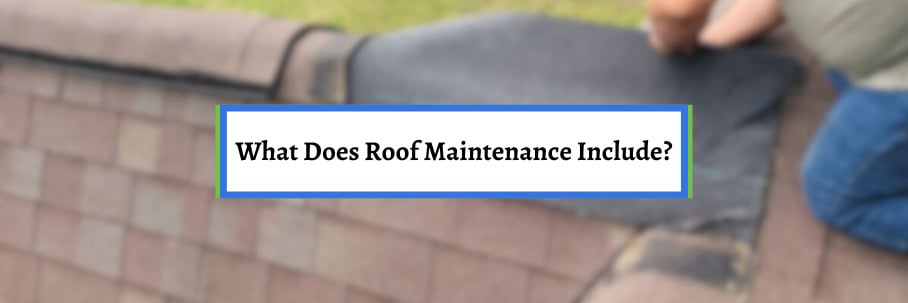What Does Roof Maintenance Include?

Do you keep hearing that your roof needs maintenance? Are you skeptical because you don’t know what maintaining your roof actually looks like?
Just like a car, maintenance keeps a roof running smoothly throughout its life. In fact, maintenance plays a huge role in how long a roof ends up lasting.
But I understand not wanting to pay for it without knowing what roof maintenance includes.
For over 30 years, Bill Ragan Roofing has educated homeowners on everything a homeowner can do to maximize their roof investment. So, let’s break down what you can expect to happen when a roofing contractor maintains your roof.
By the end of this article, you’ll have the answers to:
- What does roof maintenance include?
- How often does your roof really need maintenance?
What does roof maintenance include?
The main thing included in maintenance is simply a general inspection of your roof's overall condition and health. The roofing contractor will look for any potential leaks or damage and ensure it’s fully functioning.
This is also the perfect time to learn how much time is left until your roof needs to be replaced. While almost everything else we’ll cover here is checked, roof maintenance goes further than a standard roof inspection.
Let’s look at everything included in a roof maintenance inspection.
Smaller repairs
If you’re getting an inspection as part of a maintenance program, the cost of small repairs is usually included. So, things like nail pops or a missing shingle or two will be fixed during roof maintenance.
This not only saves you money but also stops future problems before they become expensive and cause interior damage. However, this varies by the roofing contractor offering the maintenance program.
Some may offer discounts on the repairs, while some may do them on the spot for free and let you know afterward. So, ask the roofing contractor what happens if they find problems during the maintenance inspection on the front end.
Checking pipe boots
Pipe boots are a neoprene (synthetic rubber) flashing installed around plumbing or vent pipes that come through a roof. Over time, cracks form and can allow water to follow the pipe into your home.
All pipe boots are checked during roof maintenance and replaced if needed. This is one of (if not the most) common roof leaks in residential roofing because boots won’t outlast the roof system.
But with roof maintenance, you’ll catch them before leaks can cause interior damage and lead to expensive drywall repairs. While plumbing and vent pipes are the main concern, they’ll also check the flashing or boots around other penetrations.
Inspecting roof flashing
Roof flashing is metal installed in areas where shingles butt up against something (walls, chimneys, valleys, skylights, etc.) to direct water away from areas prone to leaks. It’s one of the most crucial roofing components, and every roof must have it in the right areas.
During roof maintenance, the roofing contractor inspects the metal for rusting, damage, or installation issues. You can’t imagine the amount of water that leaks into a home’s interior from failed or damaged flashing.
So, ensuring there are no issues with regular maintenance inspections can save you thousands of dollars in potential damage and repairs.
Removing sitting debris
One of the most important things included in roof maintenance is removing sitting debris, especially in roof valleys. If leaves, sticks, and other debris build up, a dam forms on your roof that doesn’t allow water to drain down your roof properly.
This causes water to back up, get under the shingles, and leak inside your home through the path of least resistance. Removing debris blockage is one thing, but they’ll also remove any piles of debris just sitting on the roof.
Debris becomes oversaturated the longer it sits, which damages and shortens the lifespan of the shingles below. It also encourages moss growth that eats away at certain minerals embedded in shingles.
Looking for any signs of animal intrusion
Attics are the perfect safe place for squirrels, raccoons, and other small animals. Unfortunately, they gain access through your roof or roof line by creating large holes.
Creating leaks is bad enough, but they can also severely damage your home by chewing on the electrical wiring and creating a biohazard with their waste. While they won’t remove them, a roofing contractor looks for signs of animal intrusion during roof maintenance.
If there is, they’ll make a game plan to repair the area where the animals gain access. And once the area is fixed, you can start looking at ways to prevent it from happening again.
Checking if roof vents are functioning properly
One of the most important things a roofing contractor does during roof maintenance is checking the roof vents. They’ll make sure the vents are fully functioning and there are no blockages preventing air flow.
Your attic’s ventilation system and its roof vents are crucial to a roof’s lifespan. If they can’t do the job properly, your roof will fail prematurely, your energy bills will increase, and health hazards like mold can thrive.
So, making sure they’re functioning correctly is a big deal after installation and as the years go by with roof maintenance.
Gutter cleaning
While it varies by roofing contractor, roof maintenance usually includes gutter cleaning. This may not be on the roof itself, but keeping your gutters clear is crucial to your roof and home.
The main reason is to prevent built-up debris from sending water behind your gutters. This rots the soffit, the edges of your roof decking, the wood around your windows, and leaks into your interior walls.
If they’re too full, you also have to worry about gutters pulling away from the wall leading to even worse damage. However, the debris itself also causes problems because it doesn’t really get the chance to dry out.
This creates a great place for mold/mildew to thrive, which can lead to health problems when the mold spreads with the water overflowing the gutters. If that isn't bad enough, water from overflowing the gutters also washes out areas around your foundation.
How often does your roof really need maintenance?
Depending on the type of roofing material, roof maintenance can be done on an annual, biannual, or quarterly basis. Some can even go a year or two without it.
However, I always recommend maintaining your roof at least once a year. I even think getting it twice a year when Spring goes to Fall and Winter goes to Spring is worth it.
At the end of the day, it’s up to you to decide how often to maintain your roof. The important thing is that you actually get roof maintenance.
This maximizes your roof’s lifespan and saves you money in the long run. I understand it’s hard to keep up with yearly inspections, especially if there’s no current problem.
Fortunately, signing up for a maintenance program ensures you get a yearly inspection without having to think about it.
How much does roof maintenance cost?
Now you know what roof maintenance includes and how often your roof should be maintained. Roof maintenance is absolutely crucial to your roof investment and how long it lasts.
So, I don’t recommend it just to get you to spend more money. In fact, doing it means maximizing your roof and spending less money in the long run.
However, I also understand pricing is usually a concern. So, the cost is probably a big factor when deciding to maintain your roof.
That’s why I wrote another article breaking down how much roof maintenance costs.
Check out How Much Does Roof Maintenance Cost to learn the price you can expect to pay when a roofing contractor performs roof maintenance.


